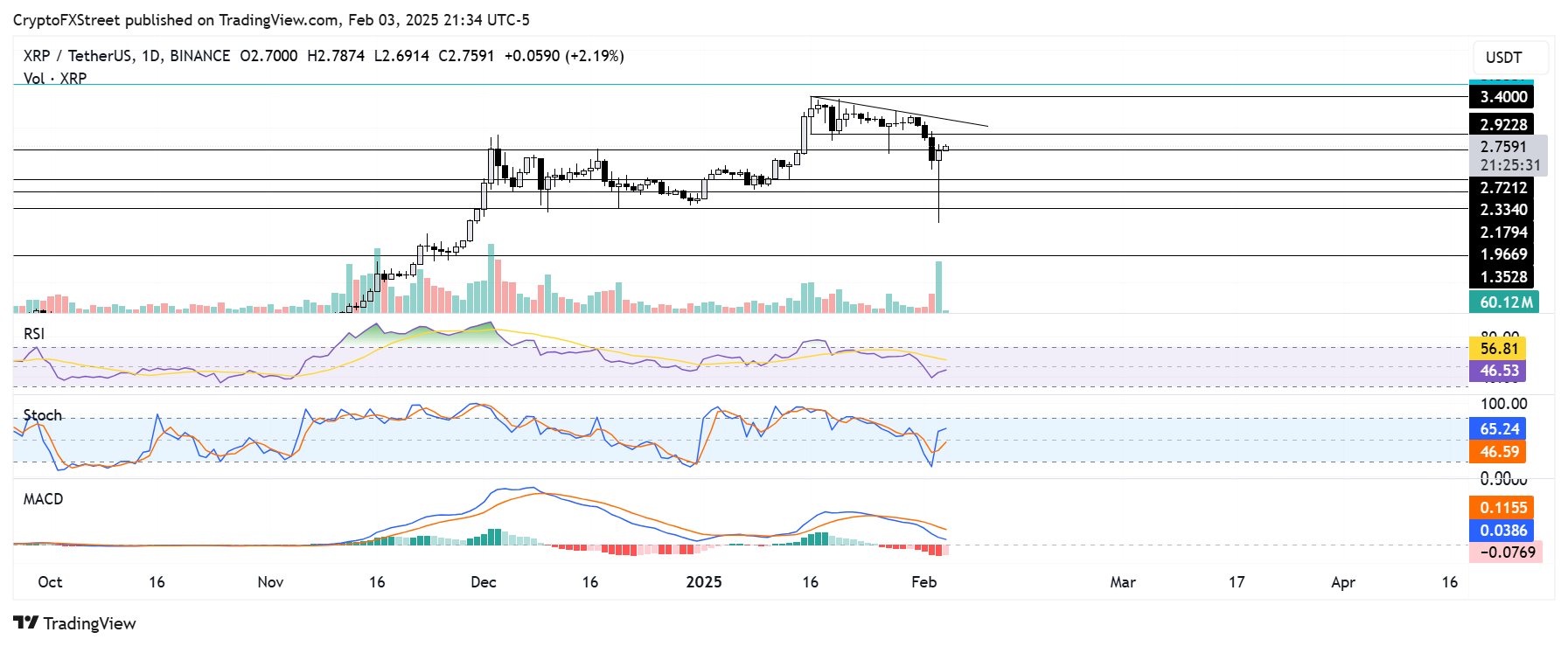Ripple's XRP stages comeback, gains 30% despite increased bearish sentiment in crypto market
- XRP investors have realized nearly $2 billion in profits in the past three days following Trump's tariff on Canada, Mexico and China.
- XRP's weighted sentiment and funding rates have plunged to significant low levels, indicating a potential bottom.
- XRP set to reclaim the $3.00 psychological level but faces a descending trendline resistance.
Ripple's XRP is up 30% in the early hours of Tuesday as bulls are looking to stage a recovery from the recent crypto market crash. While on-chain data shows prevailing bearish sentiment in the market, bulls could return to help the remittance-based token secure a move above the $3.00 psychological level.
XRP on-chain data reveals extent of recent market crash
Since the crypto market crash after Trump announced tariffs on Canada, Mexico and China, XRP investors have realized nearly $2 billion in profits in the past three days — one of the highest in its history.
 [03.22.17, 04 Feb, 2025]-638742341217334189.png)
XRP Network Realized Profit/Loss. Source: Santiment
The selling activity was dominated by whales across the long-term and short-term holders’ cohort, as indicated by spikes in the whale transaction count and Dormant Circulation.
 [03.35.51, 04 Feb, 2025]-638742341726695800.png)
XRP Whale Transaction Count (>$100K and >$1M). Source: Santiment
The high selling activity has sent XRP's Weighted Sentiment — which measures the overall average social volume relative to its negative/positive bias — to lows last seen in November.
 [02.05.26, 04 Feb, 2025]-638742342172438574.png)
XRP Weighted Sentiment. Source: Santiment
XRP Funding rates also plunged to lows last seen in August. Funding rates are periodic payments between traders to ensure crypto derivative contracts maintain parity with their underlying spot counterparts.

XRP Funding Rates. Source: Coinglass
It's important to note that prices often tend to go in the opposite direction when such high negative sentiments drive the crowd. This partly explains why XRP has staged a comeback, gaining over 30% in the past 24 hours.
However, XRP bulls need to return to the market to strengthen the comeback as XRP's open interest has failed to rise with the market after plunging from 2.05 billion XRP to 1.50 billion XRP. The low interest rate shows a reluctance among investors to hold large positions in the remittance-based token.

XRP Open Interest. Source: Coinglass
XRP eyes recovery above $3.00 psychological level
XRP saw a sharp decline below the $2.00 psychological level on Monday, sparking $103 million in futures liquidations in the past 24 hours - its highest single-day futures liquidations in the current market cycle, per Coinglass data. The total amount of liquidated long and short positions accounted for $74.67 million and $28.28 million, respectively.
Following the general crypto market recovery, XRP is looking to reclaim the $3.00 psychological level. A successful move above this level could see the remittance-based token stage a move to tackle its seven-year high resistance of $3.40.

XRP/USDT daily chart
However, it faces a descending trendline resistance, extending from January 16. If XRP clears this resistance alongside the $3.40 level, it could rally to a new all-time high above $3.55.
The Relative Strength Index (RSI) and Stochastic Oscillator (Stoch) are trending upward, with the latter crossing above its neutral level. This indicates rising bullish momentum.
A daily candlestick close below the $1.96 support level will invalidate the bullish thesis.
SEC vs Ripple lawsuit FAQs
It depends on the transaction, according to a court ruling released on July 14, 2023: For institutional investors or over-the-counter sales, XRP is a security. For retail investors who bought the token via programmatic sales on exchanges, on-demand liquidity services and other platforms, XRP is not a security.
The United States Securities & Exchange Commission (SEC) accused Ripple and its executives of raising more than $1.3 billion through an unregistered asset offering of the XRP token. While the judge ruled that programmatic sales aren’t considered securities, sales of XRP tokens to institutional investors are indeed investment contracts. In this last case, Ripple did breach the US securities law and had to pay a $125 million civil fine.
The ruling offers a partial win for both Ripple and the SEC, depending on what one looks at. Ripple gets a big win over the fact that programmatic sales aren’t considered securities, and this could bode well for the broader crypto sector as most of the assets eyed by the SEC’s crackdown are handled by decentralized entities that sold their tokens mostly to retail investors via exchange platforms, experts say. Still, the ruling doesn’t help much to answer the key question of what makes a digital asset a security, so it isn’t clear yet if this lawsuit will set precedent for other open cases that affect dozens of digital assets. Topics such as which is the right degree of decentralization to avoid the “security” label or where to draw the line between institutional and programmatic sales persist.
The SEC has stepped up its enforcement actions toward the blockchain and digital assets industry, filing charges against platforms such as Coinbase or Binance for allegedly violating the US Securities law. The SEC claims that the majority of crypto assets are securities and thus subject to strict regulation. While defendants can use parts of Ripple’s ruling in their favor, the SEC can also find reasons in it to keep its current strategy of regulation by enforcement.

